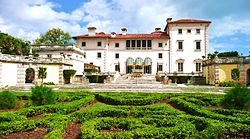Villa Vizcaya
|
Vizcaya
|
|

Vizcaya, February 2011
|
|
| Location | 3251 South Miami Avenue Miami, Florida, United States |
|---|---|
| Coordinates | 25°44′37″N 80°12′37″W / 25.74361°N 80.21028°WCoordinates: 25°44′37″N 80°12′37″W / 25.74361°N 80.21028°W |
| Area | 43 acres (17 ha) |
| Built | 1914–23 |
| Architect | Paul Chalfin, F. Burrall Hoffman, and Diego Suarez |
| Architectural style | Mediterranean Revival Style; with Baroque,Italian Renaissance,Italian Renaissance Revival |
| NRHP Reference # |
70000181 (original) 78003193 (increase) |
| Significant dates | |
| Added to NRHP | September 29, 1970 |
| Boundary increase | November 15, 1978 |
| Designated NHL | April 19, 1994 |
Vizcaya Museum and Gardens, previously known as Villa Vizcaya, is the former villa and estate of businessman James Deering, of the Deering McCormick-International Harvester fortune, on Biscayne Bay in the present day Coconut Grove neighborhood of Miami, Florida. The early 20th century Vizcaya estate also includes: extensive Italian Renaissance gardens; native woodland landscape; and a historic village outbuildings compound. The landscape and architecture were influenced by Veneto and Tuscan Italian Renaissance models and designed in the Mediterranean Revival architecture style, with Baroque elements. Paul Chalfin was the design director.
Miami-Dade County now owns the Vizcaya property, as the Vizcaya Museum and Gardens, which is open to the public. 'Villa Vizcaya' is served by the Vizcaya Station of the Miami Metrorail.
The estate property originally consisted of 180 acres (730,000 m2) of shoreline Mangrove swamps and dense inland native tropical forests. Being a conservationist, Deering sited the development of the estate portion along the shore to conserve the forests. This portion was to include the villa, formal gardens, recreational amenities, expansive lagoon gardens with new islets, potager and grazing fields, and a village services compound. The villa was built primarily between 1914 and 1922, while the construction of the extensive elaborate Italian Renaissance gardens and the village continued into 1923. During the World War I years building trades and supplies were difficult to acquire in Florida. Vizcaya is noteworthy for adapting historical European aesthetic traditions to South Florida's subtropical ecoregion. For example; it combined imported French and Italian garden layouts and elements implemented in Cuban limestone stonework with Floridian coral architectural trim and planted with sub-tropic compatible and native plants that thrived in the habitat and climate. Palms and Philodendrons had not been represented in the emulated gardens of Tuscany or Île-de-France.
...
Wikipedia



